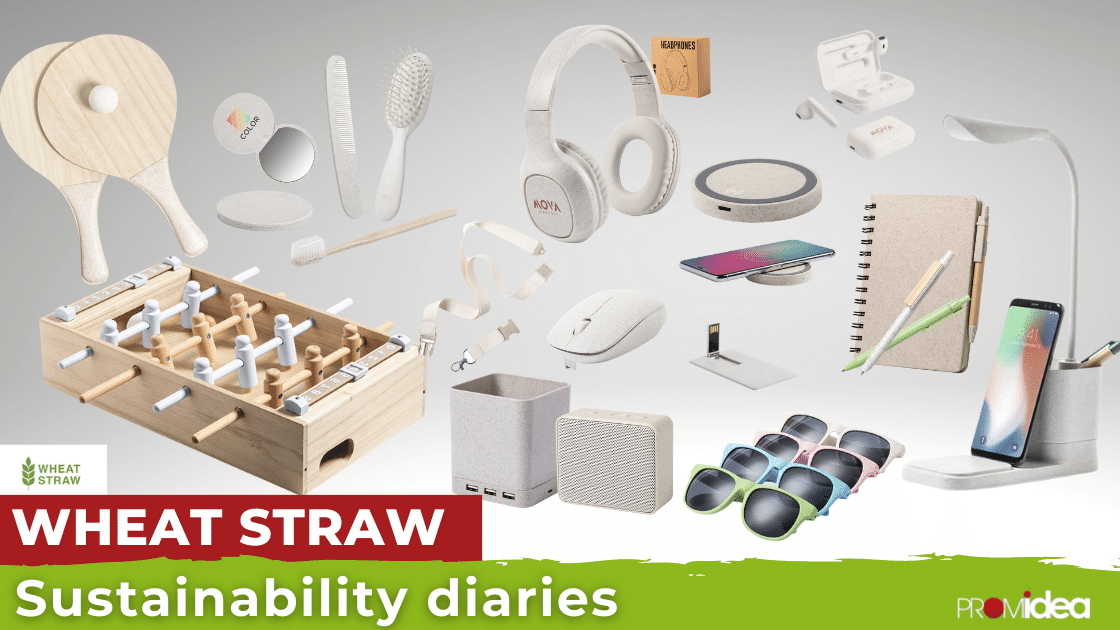Definition:
Wheat Straw is obtained from organic waste of the remains of the wheat harvest. The very same straw that’s used as cattle feed can also be reused and it contributes to the reduction of the use of plastics in a remarkable way, resulting in durable, versatile and resistant compounds, which can be applied in the elaboration of infinite products such as clothing, gagets, pens, packaging, paper and more.
How it's made:
Once the wheat has been harvested, the by-product: the straws, contain lignin. Lignin is part of the plant that makes sure that it can keep standing. It’s like the thick trunk of a tree but made for a smaller plant. In combination with sugar, lignin can be turned into a bioplastic. However, the lignin needs to be broken down first in order to make plastic out of it. The University of Warwick in the UK has found that a bacterium called the Rhodococcus jostii (which is found in soil) helps to break down lignin. This bacterium is able to produce acid, which breaks down lignin (and other materials) easily without the intervention of man-made products. This, in itself, is better for the environment. When the lignin has been broken down and combined with sugar, it is a plastic-like substance that is moulded into forms like cups and plates.
Another way to create products using the wheat straw is by making it into a paper-like substance. The straw is turned into a pulp with the help of certain chemicals. The pulp is then pressed into a form like a plate. It’s strong and non-allergenic and doesn’t even contain gluten! This method is not limited to wheat straw; it is also possible to do this with other agricultural waste products like leaves, grass and even wood.
Key points:
Sustainable: Wheat Straw is used in plastic production and it is an ideal zero-waste option. Plastic is made from artificial polymers, but polymers created from wheat straw are fully natural. Did you know that we also can find natural in our bodies? They are represented by our nails and hair.
Biodegradable : Among the many environmental advantages that the use of wheat implies, the fact that it biodegradable make it one of the -all natural- sustainable material on the market. Therefore it takes less time to break down and is usually more susceptible to weather conditions like rain. Also, at home it takes 3 to 6 months to fully compost, but using a city program, that time period is lowered to 1 or 2 months. This also means that they will typically last 5 - 10 years and can be used daily. It’s renewable and sustainable.
Strenght : Recently manufacturers have recognized that wheat straws have value and started to incorporate it into their products. Not only the plastic obtained is renewable, but the process for turning it into a new workable material is also pretty simple. First, it is washed and turned into a pulp, then heat is applied to mold it to the desired shape. The heating process and the fiber in the straw hold the end material together.
Wheat Straw material is also:
-
-
-
-
- Non-allergenic.
- Gluten free.
- Easy to clean, sturdy and strong.
- Microwave and freezer safe.
- Without odor and will not go moldy.
- It can handle hot liquids up to 100°Celsius / 220°Farenheit
-
-
-
Low cost & energy reduction: It requires less energy to produce wheat straw plastic. The production of regular plastic uses a lot of energy and releases a lot of CO2 gases. Wheat straws require less energy because they are natural and do not need as much processing to become pulp. Added to this, they require fewer toxins, such as oil, because their natural fibres make the material sturdy enough already.
Profitability: It’s a profitable source for agricultural farmers since they can sell their waste products for a reasonable price , adding a new income from a product that in the past was just a disposable one.
Ecological Footprint: It helps save our forests because wheat straws can also be used to create paper. This material can replace paper typically used for disposable cups, plates and also plastic in the tech industry replacing gagets etc. By using agricultural waste, there is no need to chop down forests to get the needed materials.
It also cuts down on the need for disposal, which is traditionally accomplished through burning the waste, contributing to air pollution by releasing CO2 into the atmosphere.
While single-use products are not ideal, the fact is they are still mainstream. These alternatives are better for the environment than their traditional paper or styrofoam counterparts. They produce less waste, less CO2, and consume less energy in the manufacturing process.
Daily sustainable switches : How can it be used?
Wheat straw is very versatile and can be used for many different products. Since plastic made from wheat straw is very durable and heat-resistant (it can resist temperatures up to 200 degrees Fahrenheit), it’s a great material to make a large variety of wheat straw products for the market today. You can find anything from coffee mugs and cutting boards to pen, tech gagets,office supplies, accessories, beauty tools, toys and eating utensils.
With all that being said, wheat straw is an amazing material that we can use to reduce or replace plastic consumption and to stop deforestation. You may not see it in every shop, or on every shelf like some of the other materials from <<Sustainability Diaries>>, but it’s growing in popularity every day.
Giving away eco-friendly products made from wheat straw plastic as corporate and employee gifts or as marketing giveaways to strengthen your brand is a great way to show people that your company is here to support them while also being conscious about the environment and WE can help you with that!




